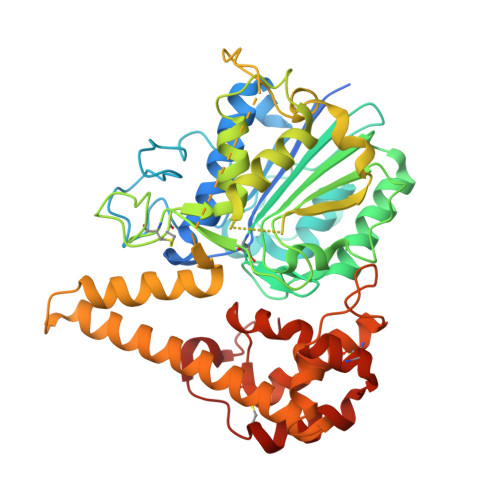The macrocyclizing protease butelase 1 remains autocatalytic and reveals the structural basis for ligase activity.
James, A.M., Haywood, J., Leroux, J., Ignasiak, K., Elliott, A.G., Schmidberger, J.W., Fisher, M.F., Nonis, S.G., Fenske, R., Bond, C.S., Mylne, J.S.(2019) Plant J 98: 988-999
- PubMed: 30790358
- DOI: https://doi.org/10.1111/tpj.14293
- Primary Citation of Related Structures:
6DHI - PubMed Abstract:
Plant asparaginyl endopeptidases (AEPs) are expressed as inactive zymogens that perform maturation of seed storage protein upon cleavage-dependent autoactivation in the low-pH environment of storage vacuoles. The AEPs have attracted attention for their macrocyclization reactions, and have been classified as cleavage or ligation specialists. However, we have recently shown that the ability of AEPs to produce either cyclic or acyclic products can be altered by mutations to the active site region, and that several AEPs are capable of macrocyclization given favorable pH conditions. One AEP extracted from Clitoria ternatea seeds (butelase 1) is classified as a ligase rather than a protease, presenting an opportunity to test for loss of cleavage activity. Here, making recombinant butelase 1 and rescuing an Arabidopsis thaliana mutant lacking AEP, we show that butelase 1 retains cleavage functions in vitro and in vivo. The in vivo rescue was incomplete, consistent with some trade-off for butelase 1 specialization toward macrocyclization. Its crystal structure showed an active site with only subtle differences from cleaving AEPs, suggesting the many differences in its peptide-binding region are the source of its efficient macrocyclization. All considered, it seems that either butelase 1 has not fully specialized or a requirement for autocatalytic cleavage is an evolutionary constraint upon macrocyclizing AEPs.
Organizational Affiliation:
School of Molecular Sciences, The University of Western Australia, 35 Stirling Highway, Crawley, Perth, 6009, Australia.















